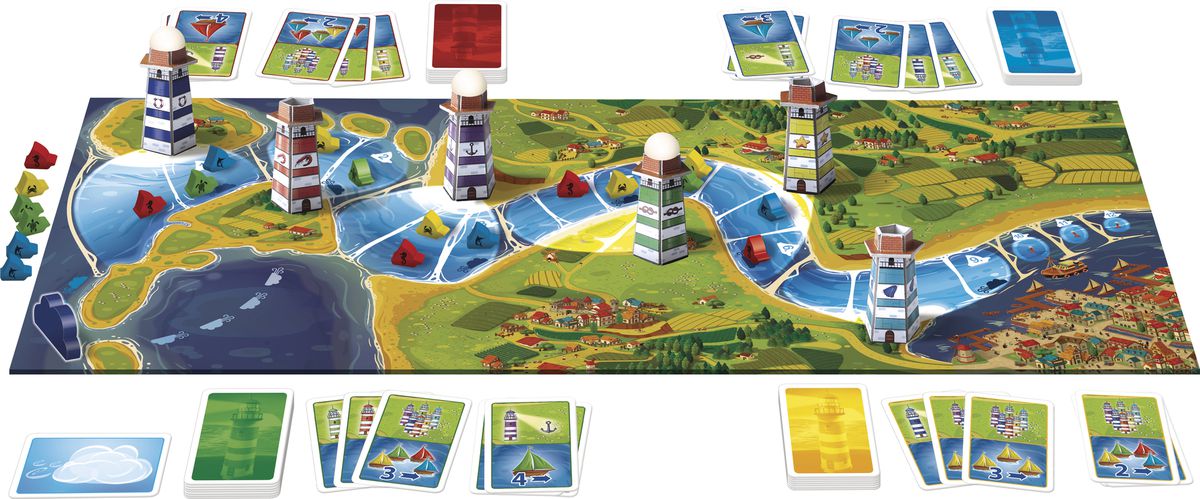For North American audiences, the largest convention of the year is Gen Con: a massive, sprawling, and even intimidating convention annually showcasing many, many new titles. It’s at least three times larger than the next biggest US board game convention and effectively takes over the entire downtown section of a small American city. It’s a major event in the board gaming world to attend, and it’s nearly impossible to catch everything that transpires there even if you tried. It’s large, busy, and has something for everyone.
Yet when it comes to game conventions in terms of the size of exhibit space, the number of attendees, the volume of new game releases, and the sheer scope of the gaming community represented, it is hard to top Essen. Gen Con is massive, but Essen Spiel is, well…Essen. Though the largest contingent of publishers and attendees is undoubtedly European-centric, Essen is a worldwide gaming event, letting you peruse titles from at least five different continents. There you can find classic German-style Euro games aside the latest Launius-esque thematic thriller next to a bevy of imports from Japan, Taiwan, and numerous other countries of Southeast Asia. War games, dexterity games, games that aren’t always the easiest to quantify – they all can be found here.
Truly, it would be almost impossible to attend Essen and not find at least one game that you would enjoy. 2018 is boasting over 1,000 games being released for the first time or in new languages for new gaming markets. Which is, quite frankly, hard to fully process. That’s more than twice the number of similar releases at this year’s Gen Con. So when people say Essen is large, they mean it.

Unfortunately for the CR, Essen is not currently a convention on our annual list. Like most outlets, we have to pick and choose which conventions we can justify, and Essen usually doesn’t fit in. We fully intend to make the trip at some point in the not too distant future, but it won’t be this year. Which leaves us, like most of you, on the outside looking in.
To that end, however, we always create a wish list of sorts to share our thoughts and help raise the profile of several titles. And we’re doing it again. Longtime listeners of the Vox Republica podcast know that we used to do an annual pre-Essen segment where we would pick five games from among the new releases that we would grab were we actually going. That’s what we have here today.
How we select these is pretty simple. First, it ideally has to be a game that we personally find creative, interesting, or innovative in some way, though it can also simply be a continuation of a mechanic or designers that we particularly enjoy. Second, and more importantly, is that as of today these titles do not have a US publisher or US distribution. Since we’d be traveling all the way to Europe, it simply wouldn’t make sense in a wish fulfillment list to fill it up with games we know we’ll have access to in a couple months. While we are personally excited for titles such as, say, AuZtralia, Blackout: Hong Kong, Passing Through Petra, Scorpius Freighter, Teotihuacan, or The Estates, they’re all going to be readily available through normal game-purchasing channels here fairly soon and therefore don’t qualify.
Instead we focus on those that may not make it here in the short term – if ever. This isn’t saying that these particular titles won’t get publication or distribution in the States down the line (and we hope they eventually do!), but as of this moment they aren’t bound for our shores.
Below are five game picks to that end. Additionally, also per tradition, we have selected one game that we feel is overhyped, and another game we feel is not getting nearly enough attention as it should be.
With that, let’s take a look at Five Games We’d Get At Essen…If We Were Going
New Releases
Our preliminary list of potential Essen games of interest bordered at around 150. Taking away those with guaranteed US releases cut that roughly in half. From there it was a matter of looking over rulebooks and factoring in how long it takes to play or its perceived replayability against the cost of the game. (Because we don’t get paid for this either, folks). From that, we whittled it down to these five games. Which wasn’t easy. This year’s list could have easily been five times as long.
Honorable Mentions: 18Lilliput, A Pleasant Journey to Neko, Pax Emancipation, Spring Rally, The Forgotten City
Ceylon
Publisher: Ludonova | Players: 2-4 | Play Time: 60 Minutes
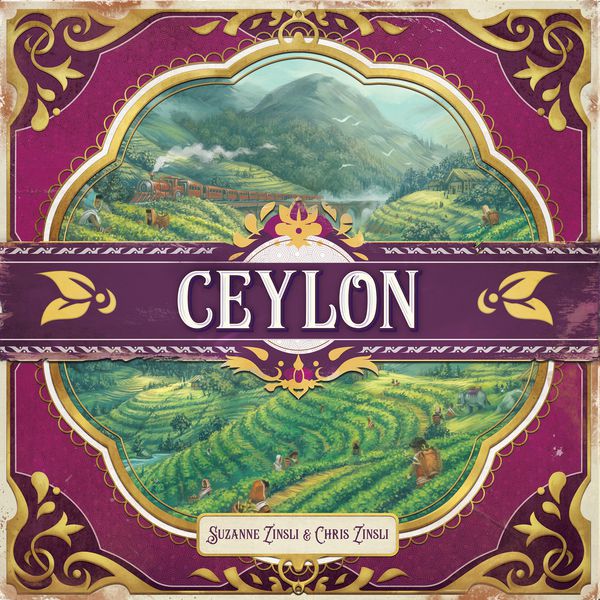 If you’ve never heard of Ceylon, then you’re probably not a tea drinker. And we promise that’s only 25% of the reason it’s on our list, with another 15% due to the fact it’s designed by our friends Chris & Suzanne Zinsli over on Cardboard Edison.
If you’ve never heard of Ceylon, then you’re probably not a tea drinker. And we promise that’s only 25% of the reason it’s on our list, with another 15% due to the fact it’s designed by our friends Chris & Suzanne Zinsli over on Cardboard Edison.
Originally the name for Sri Lanka while under British colonial rule, the namesake of Ceylon has since gone on to become synonymous with its country’s tea production – often considered some of the best in the world. Unsurprisingly, that’s what this game is all about. In this period piece game, the country’s failing coffee plantations are being converted over to tea. Your goal in this medium-weight economic game is to grow and diversify your plantations, increase your technologies, satisfy market demands, and gain influence with tea aficionados, all while also trying to make a tidy sum.
Yeah, this sounds like our cup of tea.
We’ve become fans of the small Spanish publisher Ludonova and their small but growing catalog of games; Ceylon looks well poised to continue that trend.
Gnomopolis
Publisher: Conclave Editora | Players: 1-4 | Play Time: 30-45 Minutes
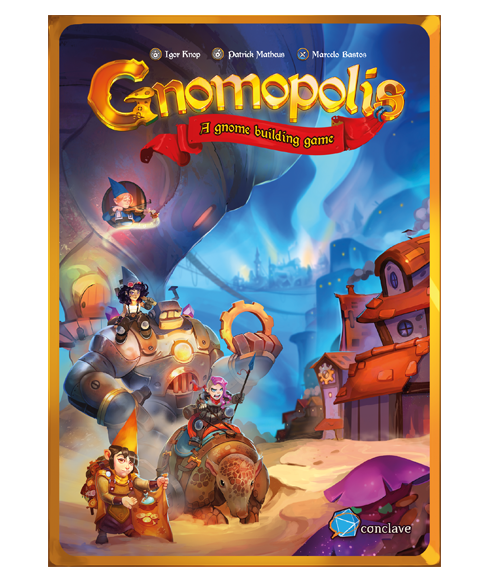 If you remember nothing else about Gnomopolis (amusingly one of two similar-sounding gnome-centric games at Essen), remember this: gnomes riding armadillos. Obviously that wasn’t the primary reason for settling on this one, but it certainly didn’t hurt.
If you remember nothing else about Gnomopolis (amusingly one of two similar-sounding gnome-centric games at Essen), remember this: gnomes riding armadillos. Obviously that wasn’t the primary reason for settling on this one, but it certainly didn’t hurt.
More generally, Gnomopolis caught our eye for being a lightweight bag-building worker placement game. In this title, the gnomes of the land are building a new capital city, which requires extensive efforts on behalf of the citizenry. Each turn players draw a handful of gnomes from their bag and use them to take various actions on their boards. Alternatively you can use them to forge new buildings in your tableau, giving you new actions to pursue as well as adding more workers to your bag. What makes it both interesting and tricky is that workers come in several different types, allowing/forcing you to focus your engine-building strategies over each game.
There isn’t direct conflict in Gnomopolis, but because your workers are telegraphed to the other players, you can definitely erect buildings to prevent them from benefiting, and not everyone loves that style of semi-interactivity. Which brings us back to its most intriguing mechanic – armadillo caravans. It’s an abstracted part of the game for sure, but each person has their own armadillo piece which you use to signify you’re take an action in another gnome’s tableau. The catch is that you can only move yours clockwise from one player to the next, adding an extra layer of timing on when and how to take advantage of your opponent’s buildings.
Shikoku
Publisher: GDM Games | Players: 3-8 | Play Time: 30-40 Minutes
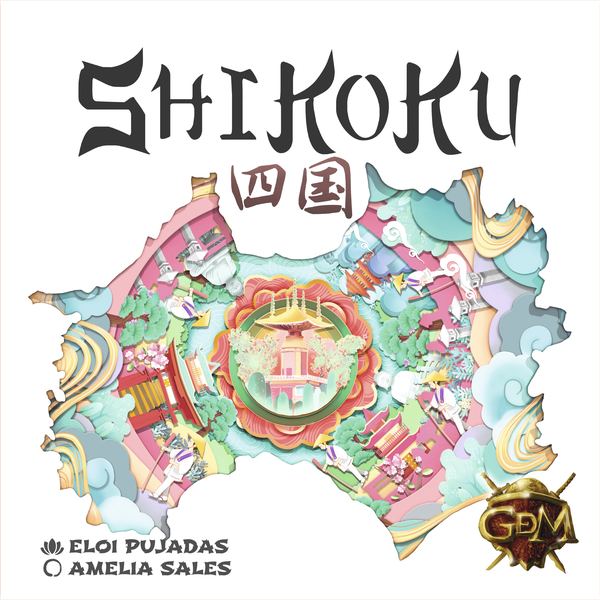 There are a lot of different things you can do with hand management games, from super complex war games to kid’s games that take more time to shuffle than actually play. There is an expansive array of options you can do with this mechanism, and it’s one we particularly like to explore. In the case of Shikoku, this comes in the form of a racing game with a twist.
There are a lot of different things you can do with hand management games, from super complex war games to kid’s games that take more time to shuffle than actually play. There is an expansive array of options you can do with this mechanism, and it’s one we particularly like to explore. In the case of Shikoku, this comes in the form of a racing game with a twist.
Shikoku is an island in Japan renown for, among other things, its well-preserved Buddhist temples. Coincidentally, that’s what this game is all about! In this fairly quick racing game, up to eight players are ascending the steps to one of the most famous of these temples by playing a numbered card each round. However, who wins and loses each round is loosely based on the game’s representation of the Buddhist philosophy of the Middle Way – preferring moderation to extremes. In game terms this means that everyone moves up the number of spaces on their card played except those with the second highest and second lowest values. Most of the cards are then drafted back to players. The process repeats itself in a rhythmic fashion until someone reaches the top…wherein the players on the second highest and second lowest steps emerge as co-winners.
Shikoku seems particularly interesting because it seems like a game that’s simultaneously embracing tactical thinking on one hand while slightly leaning in to the very real possibility of occasionally unpredictable outcomes each round on the other (especially at higher player counts). But that too is fitting in its own way. It’s a curious theme with some unconventional racing rules, and we’re interested on how this one shakes out, especially with repeated plays.
Though admittedly getting our hands on it would be taking the first step.
Tales of the Northlands: The Sagas of Noggin the Nog
Publisher: A-Muse-Ment | Players: 1-4 | Play Time: 120-150 Minutes
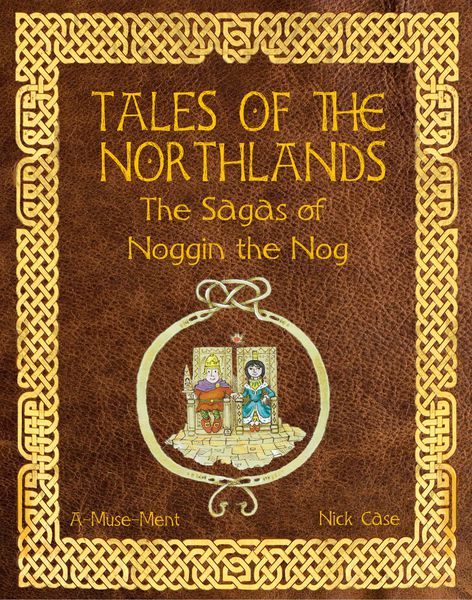 As a game, Tales of the Northlands first appeared as a successful Kickstarter earlier this year, but it makes its official debut at Essen 2018. So if you’re like us and didn’t get in on the Kickstarter, this would be your first opportunity to see it in the untamed wilds.
As a game, Tales of the Northlands first appeared as a successful Kickstarter earlier this year, but it makes its official debut at Essen 2018. So if you’re like us and didn’t get in on the Kickstarter, this would be your first opportunity to see it in the untamed wilds.
Northlands is clearly a case where two different sets of players are going to be drawn to this one, but we’re sure that there’s undoubtedly overlap between the two. The first group are those who are going to gravitate to the lands of Noggin the Nog because of this game’s weight and depth. This is a medium to heavyweight semi-cooperative worker placement game wherein each player is a lord trying to help Noggin, Prince of the Nogs secure the throne and avoid losing it to his evil uncle Nogbad the Bad. Over the course of several rounds, largely dictated by a multi-tiered rondel system, players must take actions that will benefit the Prince and stave off the machinations of Nogbad. If Noggin is successful, the lord with the greatest influence wins.
The second, and likely larger group of gamers inexplicably excited about this game, are going to be those familiar with the game’s source material. Tales of the Northlands is a meticulously crafted adaptation of Noggin the Nog, a popular series of British children’s TV shows and illustrated books in the 1960s & 70s that clearly still has an audience even today (albeit a primarily UK-dominated one). The game incorporates all of the world’s major characters in some fashion, and the artwork itself is either loaned from that source material or is newly created artwork specifically for this game by one of Noggin’s co-creators (who unfortunately passed away this summer before being able to see the finished project). They pulled out all the stops to try to bring the world of Noggin to board game form, clearly.
As non-Brits who weren’t alive during the height of its popularity, we freely admit we’re in the former camp. We’d never heard of Noggin till this game and were initially focused on the interesting mechanics first, with growing appreciation for the devotion to the theme the more we learned about it. It’s clear that the designer put a lot of care and effort into creating this title, and it’s made us want to check it out all the more.
Underwater Cities
Publisher: Delicious Games | Players: 1-4 | Play Time: 80-150 Minutes
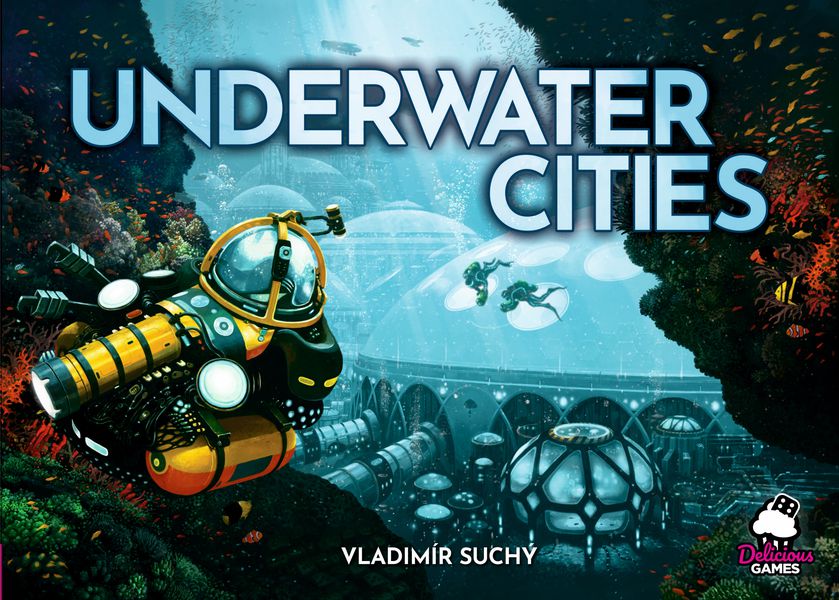 While we had a hard time narrowing our Essen wishlist down to a mere five titles, Underwater Cities was a quick and easy choice from the get-go. For starters, the theme alone is appealing. In this game, which the namesake implies, players take to the ocean depths as a means of survival. The surface world has become overpopulated and it was decided that creating aquatic living spaces was the best and most practical option.
While we had a hard time narrowing our Essen wishlist down to a mere five titles, Underwater Cities was a quick and easy choice from the get-go. For starters, the theme alone is appealing. In this game, which the namesake implies, players take to the ocean depths as a means of survival. The surface world has become overpopulated and it was decided that creating aquatic living spaces was the best and most practical option.
There are a lot of games about building and exploration, and a lot of games about the ocean. There are relatively few where the two are combined, however, making it an uncommon but appealing combination to dive into further. Any game where we can construct our own Sealab is already doing something exciting in our book.
When you then go and add depth of mechanics and strategy to the depths of the theme, we’re definitely on board. And this has those aplenty, thanks to well-known designer Vladimir Suchy. Suchy, best known for games like Shipyward, Last Will, and last year’s Pulsar 2849, has a knack for new and unconventional areas of game design, such that many of his titles tend to become rather memorable.
(They’re also almost always put forth by publisher Czech Games Edition, so we were initially confused when this one wasn’t. But it exists, so it’s still a win.)
Underwater Cities is a card driven engine game that primarily operates through the use of playing different colored cards to the board for their effects. Playing them to similarly colored card slots on the board trigger additional effects as well, enticing you to find the optimal means of gaining resources, upgrading your facility, and otherwise improving on the quality of your new home beneath the waves. There are a bevy of VP based opportunities and strategic decisions abound in this one. If you like middle to heavyweight engine games, keep it in your scopes.
Special Mention: Lighthouse Run
Publisher: Amigo | Players: 2-4 | Play Time: 20-25 Minutes
Okay, this one is a little bit of a cheat, but we also wanted to give a special shout out of joy to news that Lighthouse Run is finally getting made! This is a short card-driven filler game where you’re playing cards to race your contingent of your boats around a series of 3-D lighthouses before a storm arrives. We saw this cute title being demoed at Gen Con four years ago, but due do publisher and development issues, it’s been in limbo ever since. But it’s officially a reality! And as New Englanders, it’d almost be sacrilege for us to not mention a game involving both boats and lighthouses…
The Overhyped
With the plethora of titles that will be present at Essen, there is simply no possible way that all of them are going to generate the same level of fanfare as one another. In reality, of the hundreds and hundreds of games debuting there, most of them will regrettably come and go without much attention. On the other hand, a small percentage will go the opposite direction. Whether it’s due to the publisher or designer’s past work, pre-convention marketing buzz, or organic interest in what the game is offering, a few dozen titles going in to the convention will bring with them anticipation levels far in excess of the standard new release. Sometimes this attention is totally worth it and justified. (After all, there had to be something that drew people’s attention.) But occasionally it’s also just hype for hype’s sake.
As always with this pick, an overhyped game doesn’t inherently mean it’s bad. Rather, this just means that due to all of its inflated focus, it won’t be able to live up to the unrealistic expectations placed upon it going in to the convention. Our pick for the Overhyped Game of Gen Con 2018 is:
The River
Publisher: Days of Wonder | Players: 2-4 | Play Time: 30-45 Minutes
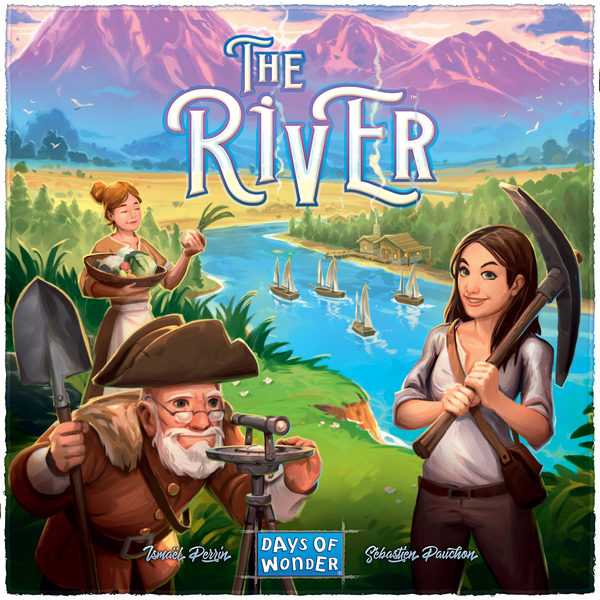 At almost 16 years old, Days of Wonder is hardly new to the board game industry. Like many veteran publishers who have cultivated their brand, Days of Wonder is sort of a known commodity at this point – as are the games that they make. This is the company that gave us titles like Memoir 44, Five Tribes, Small World, and of course, Ticket to Ride.
At almost 16 years old, Days of Wonder is hardly new to the board game industry. Like many veteran publishers who have cultivated their brand, Days of Wonder is sort of a known commodity at this point – as are the games that they make. This is the company that gave us titles like Memoir 44, Five Tribes, Small World, and of course, Ticket to Ride.
DoW has cultivated a healthy slice of the marketplace, focusing almost exclusively on interesting casual-friendly games in that light to medium-weight category. The River is no exception. In this brisk game of pioneering and developing settlements, players spend several rounds using a mix of worker placement and tile laying elements to progress along their 12 tile long stretch of river. Over this span players have to gather resources, construct buildings, and add newly explored tiles to those spaces. The catch is that adding new tiles along your river helps you get more resources, but it also slowly dwindles your storage and worker capacities as your people choose to settle down rather than keep exploring, thereby creating mild elastic tension throughout the whole game.
The main problem here is that…The River also is no exception. Much like its predecessor Quadropolis, The River from all outward appearances is a charming, affable game with the polished artwork and solid production quality that we’ve come to expect from a Days of Wonder game. It easily fits into that Gateway / Gateway Plus scope of titles that are easy to learn, don’t take long to play, and still manage to create a sense of player reward for your actions. The River is poised to do all of that. However, it also doesn’t inherently seem to do anything particularly new either. It’s billing itself as a simple worker placement game, and that’s exactly what you’re getting with it. Many people will rightfully find enjoyment with The River, but don’t expect it to be the next Ticket to Ride. For a game about exploring new horizons, this one seems to tread a lot of familiar ground.
The Sleeper
No matter how much analysis or research you perform or media reach you have, there is simply no guarantee how a game is going to be received by the hobby writ large. Bearing in mind that the most enfranchised gamers still only make up a small percentage of the overall game buying populace, it’s very easy to generate a skewed perception of anyone’s ability to correctly predict a game’s future with absolute certainty. Some games expected to do well fail miserably, and others expected to have a modest impact go on to be massive hits.
The Sleeper pick focuses on the latter. This was an exercise we started a number of years ago in trying to predict what we thought was a game at Essen with serious potential that not enough people were seemingly paying attention to going into the convention. And we’re here to do it again.
There’s not a lot to go on here besides a little bit of research, a dab of industry experience, and a whole lot of gut instinct. So it’s about as accurate as any other game expert. And so, my Sleeper pick of Essen 2018 is:
Fuji
Publisher: Feuerland Spiele | Players: 2-4 | Play Time: 30-45 Minutes
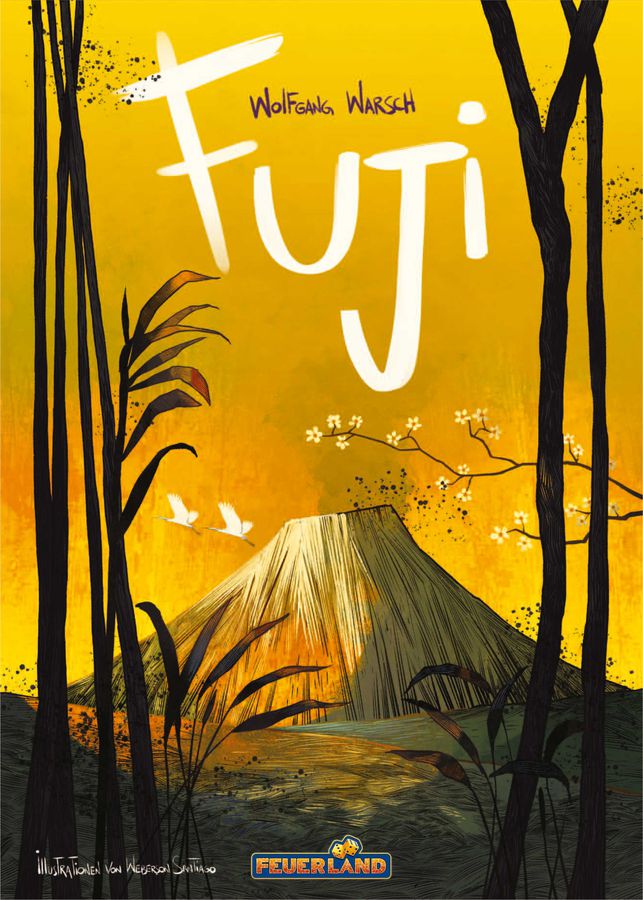 Traditionally the Essen Sleeper tends to be more strategy focused compared to something like its Gen Con counterpart. This means that it tends to be a game with appealing mechanics, copious player agency, and a grounded sense of progression. Nor does it shy away from complexity or length. These can certainly look the part of the classic Euro-style game, but by no means is that a requirement. Case in point, this year the game we think may get unduly overlooked is Fuji, a cooperative dice and tile game.
Traditionally the Essen Sleeper tends to be more strategy focused compared to something like its Gen Con counterpart. This means that it tends to be a game with appealing mechanics, copious player agency, and a grounded sense of progression. Nor does it shy away from complexity or length. These can certainly look the part of the classic Euro-style game, but by no means is that a requirement. Case in point, this year the game we think may get unduly overlooked is Fuji, a cooperative dice and tile game.
Fuji is most easily described as Forbidden Island on overdrive. In this game, players are a group of hikers who had the misfortune of deciding to hike up Japan’s Mount Fuji on the day it decides to erupt. Your goal is simple: everyone must safely make it back down the mountainside to the village safely before they’re overtaken by lava or their own fatigue. You know, because fleeing in terror has a tendency of draining you.
Staying alive is easier said than done, though, as your destination and rate of movement is determined by a combination of available tile effects and dice rolls. This includes not only your dice but those of your teammates, as dice rolls is Fuji are relational. That is, their potency is highly dependent on how they compare to the players on each side of you.
Yet those dice rolls are hidden and can’t be overtly shared until everyone decides on their intended action for the turn.
Oh, and your stamina decreases each turn based on those comparison rolls too.
And did we mention there’s lava removing tiles each turn?
Luck clearly factors in to your chances of success in Fuji, but it’s calculated in a very novel way. Plus, with ample mitigation through equipment, proper communication, nearly a dozen tile layouts, and multiple difficulty levels, there are numerous knobs you can turn here to ensure you’re not always bound for a dice-fueled death. From all outward appearances, Fuji appears concise, approachable, challenging, replayable, and it’s striking a creative- yet-familiar tone. All of which makes it an excellent candidate for widespread appeal.

